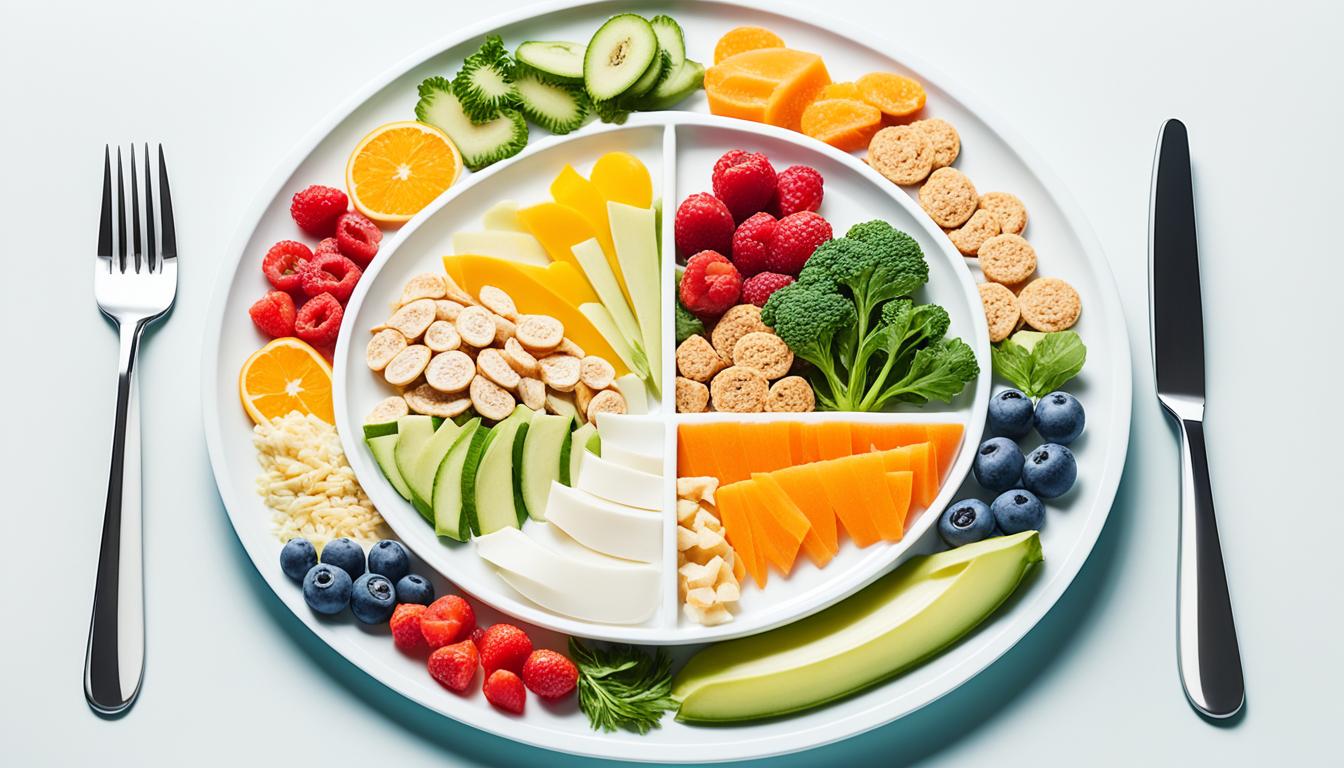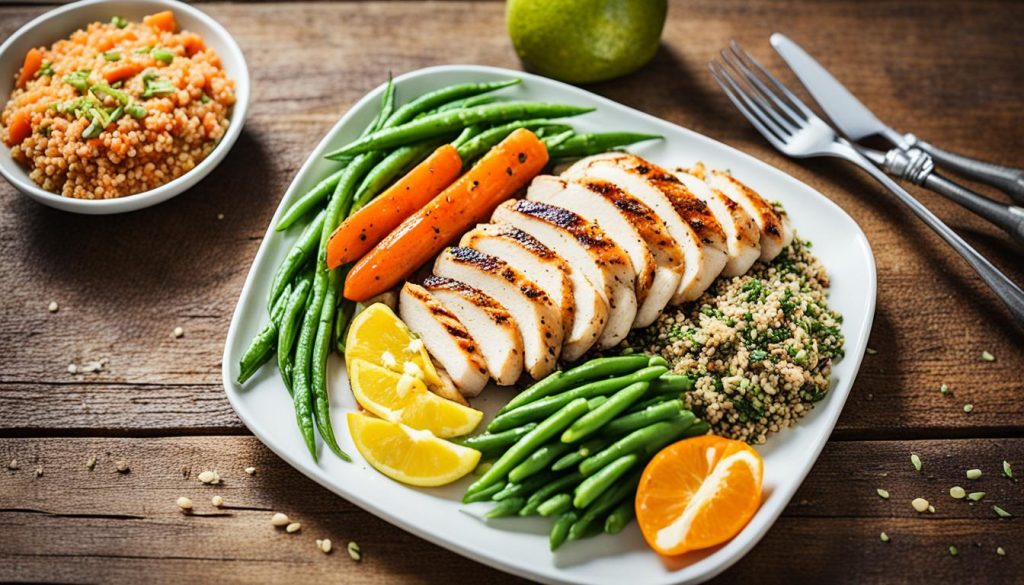30 Day IBS Diet Plan for Relief & Control
Did you know that Irritable Bowel Syndrome (IBS) affects approximately 20% of the Canadian population? That’s a staggering number of people dealing with symptoms such as abdominal pain, bloating, and digestive discomfort on a daily basis. Managing IBS can be a constant challenge, but finding the right diet plan can provide much-needed relief and help regain control over your digestive health.
Key Takeaways:
- IBS is a common digestive disorder that affects 20% of Canadians.
- A well-planned diet can help provide relief and control over IBS symptoms.
- A 30-day IBS diet plan can help identify trigger foods and establish a pattern of eating that works for you.
- The Low FODMAP diet is a popular approach for managing IBS symptoms.
- Creating a 30-day low FODMAP meal plan involves selecting foods that are low in FODMAPs.
Understanding the Low FODMAP Diet
The Low FODMAP diet is a widely recognized approach for managing symptoms of Irritable Bowel Syndrome (IBS). FODMAP, an acronym for Fermentable Oligo-, Di-, Monosaccharides, and Polyols, refers to a group of carbohydrates that can be poorly absorbed in the small intestine, leading to digestive discomfort such as bloating, gas, and abdominal pain.
In the Low FODMAP diet, individuals temporarily eliminate high FODMAP foods from their meals to alleviate symptoms. This elimination phase typically lasts for 2-6 weeks and helps identify trigger foods that may be causing digestive distress. After this period, FODMAP foods are gradually re-introduced, one at a time, to identify specific triggers and create a personalized low FODMAP meal plan.
The goal of the Low FODMAP diet is to reduce the overall FODMAP load in the diet, as certain foods can exacerbate symptoms in individuals with IBS. By eliminating and then systematically reintroducing FODMAP foods, individuals can identify their personal sensitivities and create a long-term eating plan that avoids high FODMAP triggers.
Some common high FODMAP foods that are often restricted during the elimination phase include:
- Onions
- Garlic
- Wheat
- Dairy products containing lactose
- Apples
- Mushrooms
- Artificial sweeteners
During the reintroduction phase, small quantities of these high FODMAP foods are added back into the diet one by one while closely monitoring symptoms. This process helps individuals determine their tolerance levels for each FODMAP category and tailor their meal plan accordingly.
By adhering to a low FODMAP diet, individuals with IBS can gain better control over their symptoms and improve their quality of life. It is important to work with a healthcare professional or registered dietitian when embarking on the Low FODMAP diet to receive proper guidance and support throughout the process.
| High FODMAP Foods to Avoid | Low FODMAP Alternatives |
|---|---|
| Onions | Green onions (scallions) |
| Garlic | Garlic-infused oils |
| Wheat | Gluten-free grains like rice, quinoa, and oats |
| Dairy products containing lactose | Lactose-free dairy products or plant-based alternatives |
| Apples | Blueberries, strawberries, or oranges |
| Mushrooms | Zucchini or spinach |
| Artificial sweeteners | Natural sweeteners like stevia or maple syrup |
Building a 30-Day Low FODMAP Meal Plan
Creating a 30-day low FODMAP meal plan is key to managing IBS symptoms effectively. By selecting foods that are low in FODMAPs, you can reduce digestive discomfort and promote gut health. A well-planned and balanced meal plan incorporates a variety of IBS-friendly meals that are rich in gut-friendly foods.
When designing your low FODMAP meal plan, focus on incorporating lean proteins, low FODMAP fruits and vegetables, lactose-free dairy products, and gluten-free grains. These options are gentle on the digestive system and can help alleviate symptoms associated with IBS. It’s important to ensure you’re getting all the necessary nutrients while managing your symptoms.
Here are some ideas for low FODMAP breakfast, lunch, dinner, snacks, and desserts that you can consider including in your 30-day IBS diet plan:
- Low FODMAP Breakfast: A bowl of gluten-free oatmeal topped with strawberries and a spoonful of almond butter.
- Low FODMAP Lunch: Grilled chicken salad with mixed greens, cherry tomatoes, cucumber, and a lemon-infused olive oil dressing.
- Low FODMAP Dinner: Baked salmon with roasted carrots and quinoa.
- Low FODMAP Snacks: Rice cakes with peanut butter or a handful of walnuts.
- Low FODMAP Desserts: A serving of lactose-free yogurt with a sprinkle of low FODMAP granola.
These are just a few examples to get you started, but there are countless delicious and gut-friendly options available. Experiment with different ingredients, flavors, and cooking techniques to keep your meals exciting and enjoyable.
Remember, a 30-day low FODMAP meal plan can be tailored to fit your preferences and dietary needs. Consulting with a registered dietitian who specializes in IBS or FODMAPs can provide personalized guidance and support throughout your journey.
With a carefully crafted low FODMAP meal plan, you can nourish your body while managing your IBS symptoms effectively.
Tips for Managing IBS Symptoms and Improving Gut Health
Managing symptoms of irritable bowel syndrome (IBS) and improving gut health requires a holistic approach that goes beyond just following a 30-day IBS diet plan. Incorporating certain lifestyle factors can help alleviate symptoms and promote overall well-being. Here are some tips to consider:
1. Stress Management: Stress can aggravate IBS symptoms, so finding effective stress management techniques is crucial. Practices like meditation, deep breathing exercises, and mindfulness can help reduce stress levels and alleviate digestive issues.
2. Regular Exercise: Engaging in regular physical activity can have a positive impact on gut health. Exercise helps stimulate digestion, regulate bowel movements, and reduce symptoms like bloating and constipation. Aim for at least 30 minutes of moderate exercise, such as brisk walking or cycling, each day.
3. Hydration: Staying hydrated is essential for maintaining healthy digestion and preventing constipation. Drink an adequate amount of water throughout the day and limit the consumption of dehydrating beverages like caffeinated or alcoholic drinks.
4. Meal Timing: Establishing regular meal times can help regulate digestion and minimize symptoms. Try to eat meals at consistent times each day to promote a healthy digestive routine.
5. Fiber Intake: Gradually increasing fiber intake can support healthy bowel movements. However, for individuals with IBS, it is important to choose soluble fiber sources that are less likely to cause digestive discomfort. Incorporate foods like oatmeal, bananas, and carrots into your diet to boost fiber intake without exacerbating symptoms.
By implementing these tips alongside a well-planned 30-day IBS diet, you can effectively manage your symptoms, improve gut health, and enhance your overall well-being.
Source Links
- https://www.merakilane.com/ibs-relief-30-day-low-fodmap-meal-plan-for-beginners/
- https://www.eatingwell.com/article/291572/what-to-eat-if-you-have-ibs/
- https://www.onpoint-nutrition.com/ibs-diet
- George Conway Weight Loss: My Healthy Journey! - May 19, 2024
- Menopause Diet: 5-Day Plan to Shed Pounds - May 18, 2024
- Diet Cranberry Juice: My Healthier Sip Choice - May 16, 2024





Post Comment
You must be logged in to post a comment.